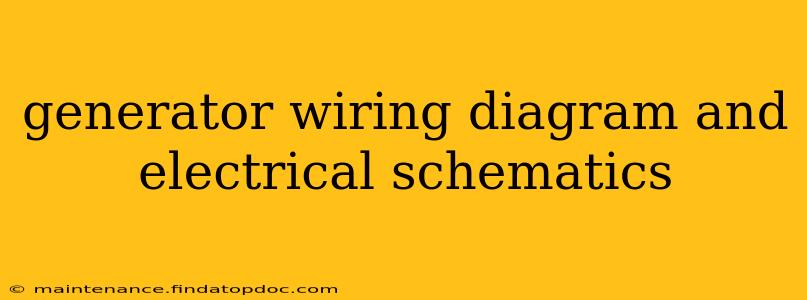Understanding the intricacies of a generator's wiring diagram and electrical schematics is crucial for safe and efficient operation. This guide will demystify these crucial documents, explaining their purpose, components, and how to interpret them. Whether you're a seasoned electrician, a DIY enthusiast, or simply curious about the inner workings of power generation, this detailed explanation will provide valuable insights.
What is a Generator Wiring Diagram?
A generator wiring diagram is a simplified visual representation of the electrical connections within a generator. It shows the path of electrical current from the generator's output to its various components and, ultimately, to the load (e.g., your home, a construction site). It's a roadmap of the electrical system, highlighting the interconnections between wires, switches, breakers, and other electrical elements. Unlike a schematic, it generally doesn't show the internal workings of individual components.
What is a Generator Electrical Schematic?
A generator electrical schematic offers a more detailed and technical representation of the generator's electrical system. It goes beyond the simple connection points shown in a wiring diagram. Schematics use standardized symbols to illustrate the electrical components and their functions, often including the internal workings of crucial elements like the voltage regulator, excitation system, and control circuitry. They are essential for troubleshooting, maintenance, and understanding the complete operational logic of the generator.
Understanding the Components in Generator Wiring Diagrams and Schematics
Both wiring diagrams and schematics will showcase key components, although the level of detail varies. Common elements include:
- Generator Head (Alternator): The heart of the system, where AC power is generated.
- AVR (Automatic Voltage Regulator): Maintains a stable output voltage.
- Excitation System: Provides the necessary field current to the generator head.
- Circuit Breakers: Protect the system from overcurrent situations.
- Transfer Switch: Allows seamless switching between utility power and generator power.
- Load Terminals: Points where the generated power is connected to the load.
- Wiring Harness: The network of wires connecting all the components.
- Control Panel: Contains various switches, gauges, and indicators.
- Batteries (for some generators): Provide power for the starting system and control circuitry.
How to Interpret a Generator Wiring Diagram
Understanding a wiring diagram involves following the lines and identifying the components. Look for:
- Wire Color Codes: Different colors usually represent different circuits or functions. Consult the legend provided with the diagram to understand the meaning of each color.
- Component Labels: Each component is usually labeled (e.g., "AVR," "Breaker 1," "Load").
- Connection Points: The diagram shows where wires are connected to each component. Tracing these connections helps you understand the flow of current.
How to Interpret a Generator Electrical Schematic
Interpreting a schematic requires a solid understanding of electrical symbols. Familiarize yourself with common symbols such as:
- Resistors: Represented by a zigzag line.
- Capacitors: Represented by two parallel lines.
- Inductors: Represented by a coil.
- Transistors: Represented by various symbols depending on the type.
- Diodes: Represented by a triangle with a line.
The schematic will use these symbols to illustrate the functionality of different circuits within the generator. Tracing the current flow through these circuits can reveal how the generator regulates voltage, manages excitation, and performs other essential functions.
What are the Differences Between a Wiring Diagram and a Schematic?
| Feature | Wiring Diagram | Electrical Schematic |
|---|---|---|
| Level of Detail | Simple, shows connections | Detailed, shows component internal workings |
| Purpose | Quick overview of connections | Troubleshooting, design, in-depth analysis |
| Symbols | Primarily lines and component labels | Uses standardized electrical symbols |
| Complexity | Relatively easy to understand | Requires more technical knowledge |
Why are Generator Wiring Diagrams and Schematics Important?
- Safety: Understanding the electrical system is crucial for safe operation and maintenance. Incorrect wiring can lead to dangerous electrical shocks or equipment damage.
- Troubleshooting: Diagrams and schematics are essential tools for identifying and resolving electrical problems.
- Maintenance: They guide technicians during routine maintenance and repairs.
- Installation: They are vital for correct installation of the generator and its associated components.
Where Can I Find Generator Wiring Diagrams and Schematics?
Wiring diagrams and schematics are often included in the generator's owner's manual. You might also find them on the manufacturer's website or through contacting their customer support. Always refer to the official documentation for your specific generator model.
This comprehensive guide provides a solid foundation for understanding generator wiring diagrams and electrical schematics. Remember, safety should always be your top priority when working with electrical systems. If you are unsure about any aspect of your generator's electrical system, consult a qualified electrician.
